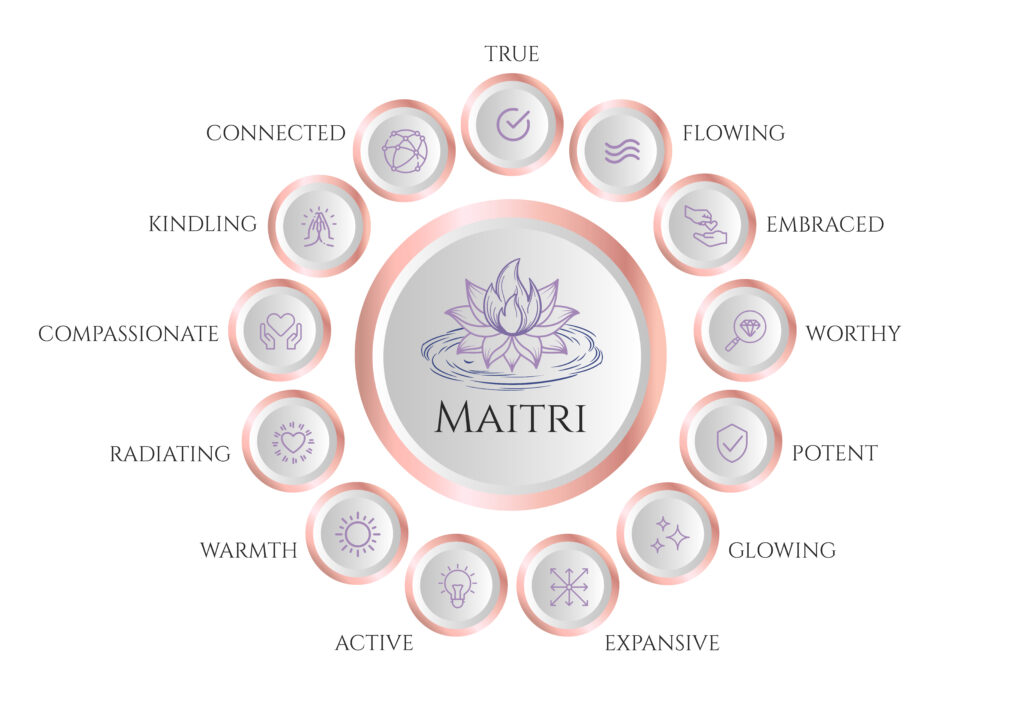We welcomed the turning of the year with the invitation to move with maitri and to take time for contemplation or meditation on the idea of friendliness to increase its effects in our lives.
Today I’ll share some reflections on how to engage in such a practice. I welcome the opportunity to hear your practice tips and processes as well!
So. How to concentrate on something intangible like an idea or an attitude?
1. We can systematically direct our mind and senses inward.
2. We can ground in the familiar, drawing from what we have learned through observation of something concrete to become a more skillful observer of subtler internal objects of meditation.
3. We can call on our memory and imaginative capacity.
4. We can balance our effort and seeking with relaxing and allowing.
Journaling and mind mapping are two methods for exploring an idea.
What words, images, sensations, experiences come to mind when you explore maitri? Some words that come up for me are warmth, worthiness, connection, and compassion.
Sometimes we can know a thing by noticing what is absent from it.
What qualities are not present when you consider maitri? Competition, condemnation, constriction come to my mind.
Now, call on a memory or use your imagination to connect to an experience where someone met you with unconditional friendliness. What did it feel like to have the fullness of your experience witnessed with open, wholehearted presence? What have you felt in holding this space for another? What do you notice in your body, breath or mind when you visualize meeting yourself with maitri? How is the dialogue different from your default inner monologue?
These exercises may be ways to contemplate maitri.

Through this process of contemplation, we utilize the mind to recall, to describe, to draw associations, to discern, to imagine. This can help to shape our understanding. Mediation can give us access to ways of experiencing outside of our ordinary thinking patterns and thereby deepen our contemplation and understanding. For this reason, you may want to utilize journaling following meditation. Meditation is also a method for crossing the bridge from conceptualizing and desiring a change to kindling transformation. Now let’s explore maitri through meditation.
Pandit Rajmani Tigunait writes, “[Typically] we employ our mind and senses to explore the objects of our desire only in the external world because we are unfamiliar with the limitless possibilities within.”.
In this writing, I’m referencing the embodiment of maitri as one of the limitless possibilities within. Embodiment is a popular term – what does it mean? In this context, to embody maitri is to be an expression of or to give a tangible form to the idea. In my experience, concentration on the formless (maitri) leads to it taking form. In meditation, it then expands back into a formlessness that can still be perceived as a permeating felt-sense. Sometimes this is followed by a state that is more challenging to describe that is perhaps the absorption of awareness into said expanded experience.
Usually when I take my meditation seat, I drift between concentration on the object (maitri) and witnessing the qualities or essence of the object (radiating warmth, wholeness, at home within) before the mind settles into experiencing for a while.

The concentration stage is the 6th limb of the astanga or 8-limbed yoga path, called dharana. The experiencing stage is the 7th limb, called dhyana or meditation, wherein the flow of concentration on the object is uninterrupted, giving rise to a sensitivity to the qualities of the thing. In my experience, when practicing meditation on a consistent focal point over time, the words, sensations, images that accompany the object of focus in the dharana phase of things become cues on the inward return path to the deep knowingness of the object which is already present inside. It is like noticing landmarks on the way to a familiar place you love: the landmarks are known, so they do not distract you but their presence assures you are headed in a welcome direction. Absorption, or samadhi, is the 8th limb of the astanga path; a direct experience of the thing in which there is no perception of being separate from it. Samyama is the simultaneous practice of these three limbs.
YS 3.24: By samyama on friendliness and other such qualities, the power to transmit them is obtained.
The capacity for unconditional friendliness toward oneself is inherently available. It is possible to transform the way you regard yourself and to express maitri not only through your speech and actions but through your very being. The inner work translates to more skillful action and easeful presence in the outer world. I hope my attempts to narrate the inner dimensions of yoga practice and the list of possible processes are helpful guides toward knowing this reality for yourself.

Meghan Hogan, E-RYT 500, CCC-SLP is Lead Faculty for the Yoga Vidya Teacher Training and In-Depth Studies program, a Speech-Language Pathologist supporting preschool children with disabilities and their families, a wife and mother.
Her mission in sharing yoga is to provide caregivers of all walks of life tools for self-care and stress management.
